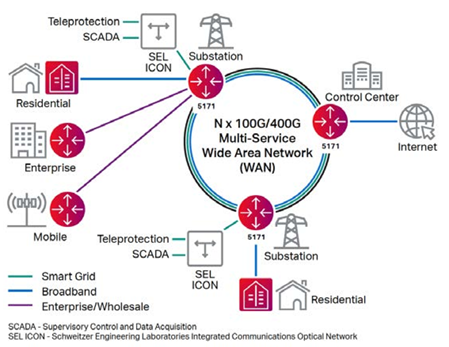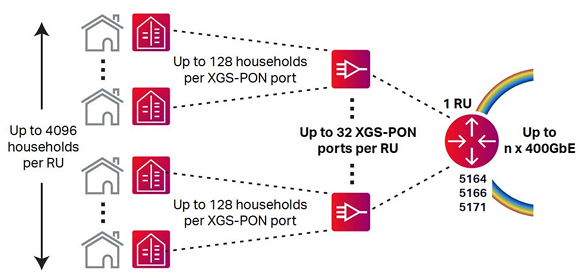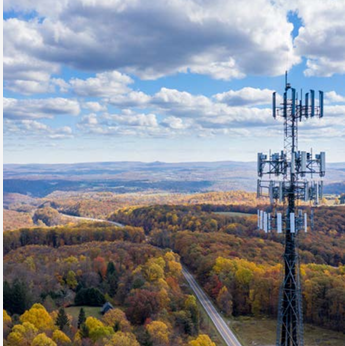
Broadband service deployment in rural communities has been limited, as it is difficult for legacy providers to justify a business case for broadband in sparsely populated areas. Consequently, the lack of adequate bandwidth for broadband presents a challenge to rural residents— from unreliable work, retail, and entertainment services to unavailable critical healthcare and advanced education services. COVID-19 has only accelerated these trends, cementing high-speed, reliable broadband as an essential service rather than a luxury, no different than other essential utilities that are taken for granted like electricity, gas, or water.

Converged residential broadband/smart grid network for utilities
Rural utilities are in the unique position of having physical infrastructure in place for electric power that can be leveraged to bridge the digital divide. But their core business remains the supply of electrical power, which needs to be delivered more cost-effectively and with fewer staff covering multiple roles. This fuels the need to emulate larger utilities in modernizing their power grid—along with automating their operations and billing—with initiatives such as the deployment of smart meters. The shift towards renewable energy generation, the growth in smart devices in homes, and the expanding electric vehicle ecosystem all create further challenges that place more strain on communications solutions for utilities.
Managing the significantly increased volume of broadband traffic—while allowing critical teleprotection traffic to be prioritized—demands a converged network for both residential broadband and smart grid services that spans both the last mile and the middle mile. This is a key factor when considering investing in a network— can it address the operational challenges of the core utility and deliver rural broadband to the communities it serves.
How is broadband becoming an essential service?
COVID-19 caused a major change in internet consumer patterns. The move to working from home—both for employed adults and students in schools, colleges, or universities— has dramatically increased the use of collaboration applications such as Zoom and Microsoft Teams, causing an exponential growth in internet traffic. And while some schools and offices have reopened, a significant portion of the home-working trend is becoming permanent. The move to remote working and learning, as well as the massive uptick in entertainment streaming services such as Netflix and Hulu, has led to an overnight shift in internet traffic consumption.
Despite the rise in traffic levels, traditional service providers’ metro networks coped well, and connectivity for consumers and businesses in urban areas remains a well-served market. Yet rural areas were already lagging even before COVID-19 in terms of broadband network reach, access speeds, and cost. Despite government incentives, it is difficult for legacy service providers to justify the capital investment across the more dispersed population that characterizes rural broadband. But high-speed broadband is essential for people living in these locations. The need for reliable broadband is now a fundamental part of their working and recreational lives—no different than electricity was over 90 years ago.
The multi-service opportunity for rural utilities

Ciena’s Residential Broadband Solution
Utilities have an existing business justification for investment in high-capacity packet-optical transport between their substations to carry traditional Operational Technology (OT) traffic. Smart grid also impacts a utility’s substation OT services, such as teleprotection for power lines which enables faster and more widespread monitoring and control at substations so the network can respond to failures with corrective action. All the while, the modernized network must continue to support, secure, prioritize, and deliver ultra-low delay connectivity for these essential mission-critical services. It makes sense for utilities to leverage this smart grid infrastructure to aggregate internet traffic from broadband services to meet the needs of their new residential and business customers. Not only does it create a new revenue stream, but also provides an essential service for their rural communities.
Delivering a converged network for smart grid and broadband services
A change of this magnitude in the network—combined with the introduction of completely new service types at the same time—may be viewed as high risk. There are also cultural factors to consider when merging the traditionally separate OT and IT network and teams. This can be mitigated with a plan that divides the transition into three steps.
The first step is to build a middle-mile network to support smart grid traffic. This provides confidence that the solution performance meets the needs of mission-critical teleprotection and other high-volume traffic, such as surveillance cameras and smart meters.
The second step is to offer residential broadband services in rural communities provided through the same network for smart grid. Ciena offers a highly scalable approach that allows utilities to easily go from tens to hundreds of XGS Passive Optical Network (PON) ports without losing sunk platform investments, replacing existing network equipment, or needing significant upfront costs. Ciena’s Universal Aggregation (UA) and access capabilities support multiple service options in addition to XGSPON.
 The final step is to offer wholesale and business connectivity services. For example, in regions with 5G rollout in progress, mobile carriers will be looking for a significant amount of additional capacity. In both the business and public sectors, there are opportunities for capacity to support business applications, telemedicine, or remote learning.
The final step is to offer wholesale and business connectivity services. For example, in regions with 5G rollout in progress, mobile carriers will be looking for a significant amount of additional capacity. In both the business and public sectors, there are opportunities for capacity to support business applications, telemedicine, or remote learning.
With this solution modularity, utilities can offer enterprise business services over IP or dedicated Ethernet and mobile wholesale services with xHaul transport capabilities. Moreover, they can have a highly-optimized footprint that reduces energy and space requirements to sustainably expand addressable market and revenue opportunities. Hardened and weatherproof platforms provide utilities with maximum flexibility and the ability to move their Optical Line Terminals (OLTs) closer to end-users for improved performance. This solution leverages the power of Ciena’s portfolio, including Routing and Switching platforms with XGS-PON pluggable technology, market-leading optical networking technology, Ciena’s Manage, Control and Plan (MCP) domain controller, Blue Planet® Intelligent Automation Software, and Ciena Services.
Broadband beyond the network elements
Utilities are looking to deliver the best Quality of Experience (QoE) to their customers while increasing operational efficiencies. As networks have grown, broadband network planning, infrastructure commissioning, service fulfillment, and service assurance can be complex. Ciena’s PON Operations, Administration, and Maintenance (OAM) software simplifies network and service management. PON OAM can be cost-effectively hosted on an external x86 server or internally on Ciena’s Universal Aggregation platforms as part of WebGUI.
Ciena’s Residential Broadband Solution also leverages Ciena’s MCP domain controller. This allows utilities to scale the network, simplify operations, reduce cost, and deliver the agility and resiliency their customers expect. It provides utilities the ability to manage and orchestrate their multi-layer network from end to end—including middle mile, last mile, and Customer Premises Equipment (CPE)—when delivering broadband, enterprise, or mobile wholesale services using a common and integrated platform.
Full support to new and existing utilities
As many utilities may not necessarily be set up to execute complex IT deployments, Ciena Services’ extensive experience, processes, and economies of scale can help assure a successful rollout. Depending on needs, Ciena Services is ready to assist—from initial planning and design, systems integration, and implementation to ‘Day 2’ services to optimize, support, and manage this powerful solution. Ciena Services also offers an extensive library of learning courses and labs to grow IT teams’ residential broadband knowledge. Ciena’s services are designed to be flexible—they are available individually or as a packaged solution—and consist of Consulting, Implementation, Systems Integration, Maintenance, Managed Services, Optimization, and Learning.
Ciena’s solution also includes the Ciena Partner Network’s Marketing as a Service program (MaaS)—an award-winning marketing service that takes network operators to market faster with collaborative engagement, execution, and dedicated marketing experts to accelerate time to revenue. Ciena not only supports the development of go-to-market strategies, but also executes to win business together.
Utilities are moving away from legacy chassis-based approaches because they simply do not offer the capacity, efficiency, or adaptability required to succeed in a highly competitive market while supporting new and emerging application requirements. Ciena leverages innovative broadband architecture and proven expertise in deploying ultra-high-capacity networks to thrive in the growing residential broadband market.
Sustainability cannot be an afterthought
 Investing in infrastructure to close the digital divide without considering all relevant environmental and economic sustainability aspects can negatively impact any service provider’s long-term financial viability.
Investing in infrastructure to close the digital divide without considering all relevant environmental and economic sustainability aspects can negatively impact any service provider’s long-term financial viability.
At Ciena, we continue to invest in the sustainability of all critical network elements by converging the access infrastructure with best-in-class routers, WaveLogic™ coherent optics, and innovative uOLTs and corresponding ONUs. Sustainability models show we have already helped our customers avoid more than 550,000 metric tons of CO2e over an eight-year period (2014–2021) with our Routing and Switching Platforms—helping our customers’ production networks achieve 23 percent savings in power consumption, equaling 96,000,000 kWh saved which resulted in $12 million per year OPEX savings.
Through our WaveLogic coherent optic investments, we introduced the industry’s first 400 Gb/s transceiver in 2017 and are delivering the pluggable version five years later at one fifth the power, one tenth the space, and with improved industry-leading systems performance.
Combining Ciena’s routing, optical, and PON innovations together offers significant improvements in footprint and power savings to enable more efficient and sustainable networks for our customers—and the planet at large. For example, evolving from a traditional pure PON chassis-based, multi-boxed solution to Ciena’s converged access with XGS-PON and routing in a single platform results in a 67 percent reduction in footprint and 63 percent reduction in power consumption. This is just one example and, when applied to 100,000 homes passed at 50 percent market share (12 sites) using a 64 OLT split, can avoid 84,400 kWh annually, resulting in 59.8 metric tons of CO2e avoided. A higher market share rate or homes passed would yield much larger sustainability results. To quantify the value of Ciena’s sustainable approach to broadband, we have partnered with ACG to develop an online business case tool that can quantify the TCO advantages of Ciena’s broadband architecture vs legacy chassis-based and closed pizza box approaches. Our subject matter experts will work with the customer to analyze their planned rollouts and develop both a 5-year TCO and ROI analysis tailored to the customer’s network needs.
We welcome utilities that are in their planning stages for broadband to reach out to us to take advantage of these on-line business case tools to aid them in their broadband journey.
This article was kindly contributed by Ciena
